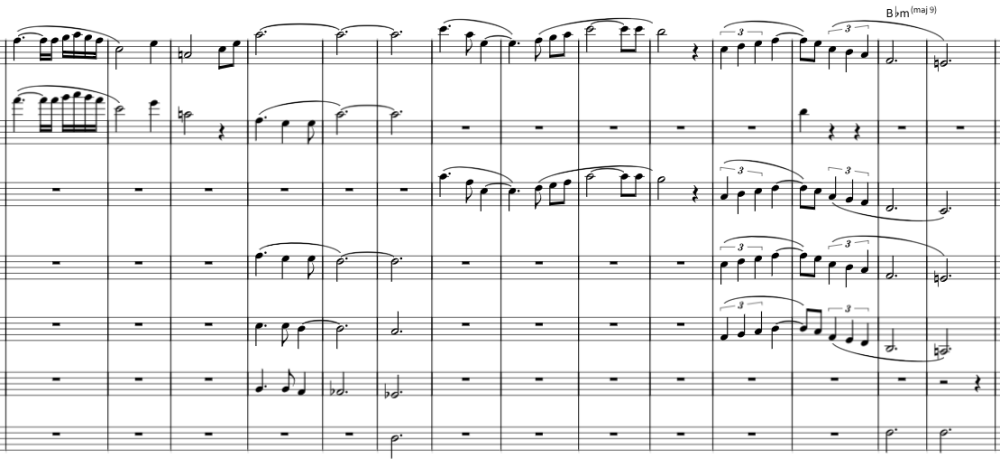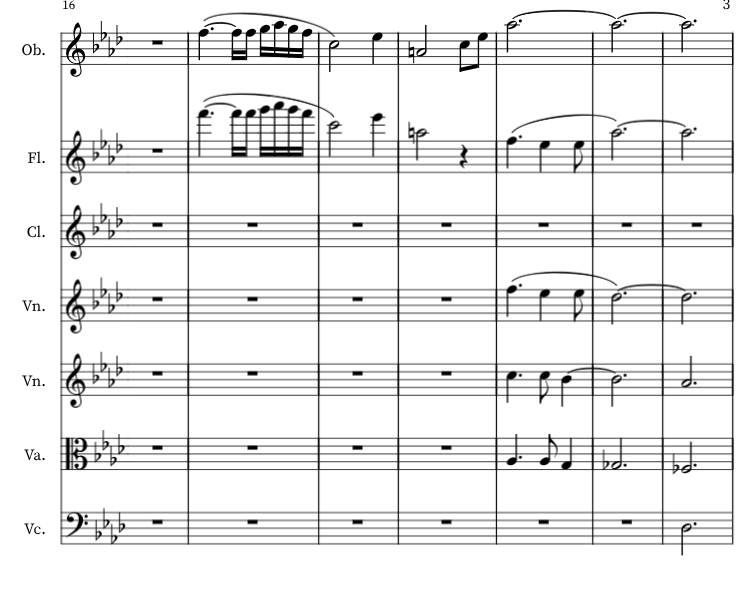All Activity
- Past hour
-
honestly I just took the fur elise midi file from musecore and It came with that 😭 I just didn't bother changing it thank you1
- Today
-
Churchcantor started following 2 Symphonic Poems and fur elise orchestrated
-
Nice orchestration. What on earth was your reason for the 2/8 plus 1/8 you arranged instead of the simple 3/8 the piece is written in?
-
The Mewlips-Tone Poem for String Orchestra
Churchcantor replied to Churchcantor's topic in Orchestral and Large Ensemble
Ah, yes; that add9 in the final cadence: when you read the poem that I set in 1993, it is about swamp monsters that eat you! An add9 chord at the end is an unresolving yet peaceful chord. There is peace in death, get it?😉 -
Well, these sound nice! Do you have the score online?
-
Henry Ng Tsz Kiu started following With Every Beat My Heart Knows
-
HoYin Cheung started following With Every Beat My Heart Knows
-
Dear all, Spoiler alert: It is a Christmas song. I will still write a "classical" Christmas piece but I got this idea first. Please feel free to enjoy it anytime you want. Recently I saw a new DAW software with good AI voices, so I wanna test it out and write a sample song for it. That turns out to be excellent (overall speaking), but sometimes the lyrics are not clearly pronounced. I might write more chroal piece with this great tool now. Feel free to tell me how it sounds! Overall structure of the song:- Orchestation: SATB + Violin "Quasi-Rondo" form: ABABCABA’ Strategy: Since it is meant to be a pop song, more direct development to "chorus" Some fun modulations involved HoYin
-

Concerto in C for Flute and Orchestra
J. Lee Graham replied to J. Lee Graham's topic in Orchestral and Large Ensemble
Really??? Jeez, I remember paying something I thought was reasonable, a one time payment. I've never been charged again. Maybe it's getting popular. Sorry guys! -
J. Lee Graham started following Calling Oboists! Need a little guidance and Requiem in Bb major - Quam Olim II
-
Wow! Some surprisingly good counterpoint, though it's difficult to see how it will all fit together without the text underlay. Consciously or not, you've taken a cue from Niccolo Jommelli (1714-1774) in scoring your Requiem for voices and strings alone...his Requiem (1756) was the most popular and often requested of its day, until Mozart wrote his in 1791. The sparing orchestration makes it more likely to get played. I agree with ComposaBoi on just about everything he said. Measure 11: The tenor part goes dangerously low, down to B below tenor C; consider a D instead if it won't mess up your counterpoint. Measure 17: Awkward for Violin I - the C on beat 3-1/2 is icky to try to reach down to there, it means shifting a third down the fingerboard for one note, then shifting back up again; consider the G above instead. Measure 31: Odd ending, it seems to me. There is no third in the chord, and while that's not without precedent, I don't feel like it works here. Consider an E-flat as the final note in the Soprano and Violin I. Show us more of this as you have it! Well done!
-
Howdy y'all! I'm writing an Oboe Quartet (Oboe, Violin, Viola, and 'Cello) and I'm wondering about the upper register of the Oboe. It's not exactly giving me fits, but I'm having trouble believing that the instrument is as limited as it seems to be, realistically. Being a Classicist, I tend to write parts that are intended to be playable on 18th Century instruments. I'm a string player, but have it on fairly good authority (and actual experience) that the Oboe, circa 1790-1800, was not really capable of playing anything above a D6 (D above high-C) reliably; there was a famous exception in the period, a virtuoso player named Friedrich Ramm (1744-1830) in Mannheim who was capable of playing an F6 (F above high-C), and it was for this player that Mozart wrote his celebrated Oboe Quartet in F, K. 370. In my own Sinfonia Concertante in C for Oboe, Bassoon, Fortepiano, Violin, 'Cello, and Orchestra, which was performed by the Austin Baroque Orchestra on period instruments (the oboe soloist's instrument was a copy of an original from 1806), I wrote a couple of E6s (E above High-C) that didn't come out well in performance, despite the excellence of the soloist otherwise, and that has made me hesitant to write anything in my other works for the oboe any higher than D6, even in my Oboe Concerto. Now I'm wondering if that register above D6 is difficult or unreliable on a modern Oboe. What do you guys think? I've had to rethink a couple of passages in this piece I'm working on, and I'd like to know if I'm being a little skittish. For that matter, if you think my experience with my Sinfonia Concertante was not representative of what a really good player should be able to play, I'd like to know that as well. Thanks in advance.
-
So I've been revisiting the "Metroid" series of Nintendo games from my childhood. Played through Prime and now Dread, which is the newest one until Prime 4 comes out in a couple weeks....it's not one of the better entries. But what stood out to me is the music. This is from the opening of the game. That is a very...not-convincing orchestral mockup, I must say. Definitely not for 2021. When I did my first game score 15 years ago now (omg), this sort of mockup would've gotten you laughed out of the building in the West. Even indies wouldn't have hired you unless it was a pixel-art throwback game and even then you're pushing it. I remember when I did my first soundtrack which was for a couple of Ubisoft devs back then, they were obsessed with "real", and even EWQLSO wasn't enough for them. But I remember reading a few years ago on Redbanned there was a survey, and Japanese composers still most often use Symphonic Orchestra Gold. It's very odd to me and something I"ve noticed specifically in Japanese video games. Not so much in film and TV — I see people from Japan regularly dropping killer mockups of John Williams and such on YouTube, but professional Japanese game devs really don't seem to care. Demon's Souls sounds like it used straight up ROMpler and "General MIDI" patches as well. Just abysmal. I wonder why in Japan they seem so unbothered by it? You'd think especially companies like Nintendo, who are so big on quality-control everywhere else and have these iconic melodies from like Mario and Zelda would demand only the best production quality?
-

Oboe Concerto
BlackkBeethoven replied to BlackkBeethoven's topic in Incomplete Works; Writer's Block and Suggestions
Yes, which I really like...my progression has some of that, but it's not as dramatic as I would've wanted. Yes lol...That was just some material that I had written previously that I harmonized...I tend to write like I'm making a quilt, little sections here and there until it comes together. - Yesterday
-
I’ve been improvising all kinds of music including Movie soundtrack like parts. It’s intimidating way of working - one wrong keypress on keyboard and the recording becomes unusable. In this EXPERIMENT below I am playing over a pre-made baseline with strings. Began using improv as a way to make my music-in-mind-to-computer ability better. Thoughts?
-
.thumb.png.8b5b433a341551e913a34392660bc95b.png)
Oboe Concerto
PeterthePapercomPoser replied to BlackkBeethoven's topic in Incomplete Works; Writer's Block and Suggestions
To me, the whole point of having a pedal tone over some changes is that at some point or another it becomes a non-harmonic tone in relation to the harmony which brings in some nice dissonant color. But your plan of having AbM-EbM/G-Gbmaj9-Dbm works because the G's and Gb's are dissonant with Ab. Now, the only thing that puzzles me is .. why did you take the trouble of modulating to Db minor if you immediately go back to Ab major? I thought you were going to stay in the Db minor key longer to introduce a contrasting theme or something? -

Oboe Concerto
BlackkBeethoven replied to BlackkBeethoven's topic in Incomplete Works; Writer's Block and Suggestions
-

Oboe Concerto
BlackkBeethoven replied to BlackkBeethoven's topic in Incomplete Works; Writer's Block and Suggestions
Hmm, why is that? I was thinking about bringing in some NRT and going AbM-EbM/G-Gbmaj9-Dbm But not exactly sure how I should orchestrate that, b/c I liked it on the piano, but in the strings, it's kind of wonky lol -
Henry Ng Tsz Kiu started following Exposition of Fugue in D major - WIP
- Last week
-
I tried to make a song based off early internet viruses, even from before I was born using my notations software's transistor bass, made in 1988 with it unchanged since. sorry for the audio being absolutely chopped and laggy, i just might of went a bit crazy with the drums😅
-
“Greetings, dear composers. And with this Allegro, my second sonata is complete, and I am very happy and satisfied with the entire work. This movement is like etude of modulations, but I believe I have refined it well enough for everything to sound natural and have the right balance. I hope you like it.”
-
- 1
-

-
i see sonata, i click this is magnificent. the motivic interactions... harmonic blending... so good. too long for my internet attention span. but I think it could work in a concert hall very well. and impressive fast octaves! very needed when it is the main motif one thing but that is personal opinion, the open octave accompaniment might sound a bit too hollow (like bar 67), does work better if the register is lower (like bar 17, 274 etc.) bars 189b-191a why suddenly regular triplets instead of the dotted? I find it becoming "too baroque" for a few seconds, especially with the traditional harmonies there. Again, opinion only, and I have no professional qualifications lol
- 1 reply
-
- 1
-

-
After the tense Halloween competition I needed some time to relax, and what better way to do that than to compose a new piece? So today, I'm taking the opportunity to present my first steps here as a “work in progress” in order to get feedback before I finish it (since it's sometimes difficult to incorporate suggestions after that). First some background about the ideas I had in mind for this piece: As often, I would take the challenge to use an odd meter, therefore here in 10/8 introducing a 5-beat rhythm. There were also some pieces in my mind which would influence the idea and texture of the fugue: In Leonhard Bernstein’s „Chichester Psalms“ there is a movement in 10/4 meter with very slow slurs, a slur spanning 5 notes, and below that 2 small slurs, each spanning 2 and 3 notes respectively. https://youtu.be/PnrZGTmMjYc?t=728 On the other hand, Bach’s „Et in terra pax“ from the b minor mass also has that slow-flowing mood with tied second steps (while in 4/4 time) and is a wonderful example for the festive D major. https://youtu.be/p16wOPrX7Rk?t=104 The third piece I had in mind is Bach’s G sharp minor fugue, BWV 887, from WTC2. It has a continuous texture of 8th notes (here in 6/8 time) and is a perfect example for rhythmic counterpoint in such a texture. https://youtu.be/1iHpPR9xzk8?t=115 And there is the „funny“ fugue in A major from Shostakovich’s op 87 which has a subject which is usually not a real fugue subject since it consist only of very consonant chord arpeggios, however in the end it is a marvelous fugue with a wonderful harmony and texture! https://youtu.be/Qe1vF0bgmb4 So I present here the fugue exposition (and the first episode). The subject (in its first entry) is in D lydian, but modulates to a repetition of first motif in E major as the end of the subject (so its easy for the answer to enter in A major, finally modulating to b minor). After the second entry of the subject there is a short codetta modulating to c sharp minor, so that the third entry of the subject in D lydian produces an interesting appearence as Neapolitan chord. Apart from the harmony, it was a challenge for the counterpoint to find rhythmic patterns that create an interesting overall texture on the one hand, but do not destabilize the 10/8 rhythm on the other.
-
look @Henry Ng Tsz Kiu it has only been a year of me exploring the pipe organ lol but thanks for tagging. surprised you weren't interested in those random pauses... I like the modal harmonies of the piece but I think it would really benefit from specifying the registrations, as the score currently stands doesn't look idiomatic for the organist, and the default computer playback isn't doing wonders
- 3 replies
-
- 2
-

-

-
- old pieces
- deleted pieces
-
(and 1 more)
Tagged with:
-
BrandonPozzo joined the community
-
Audrey Perkins joined the community
-
I would second that. I can't really get a good impression of your piece from Noteflight, the playback is too ropey. (That may be why you're not getting many reviews.) MuseScore would give a much better rendition of your score, even with no tweaks whatsoever.
-
The counterpoint is very impressive, so well done! I would have liked to see how the lyrics align with the notes, but I'm not sure if note flight is capable of that. I would definitely recommend musescore if you can fit it on your computer. It is free after all. The main issue is how you're writing for your forces. Violin octaves are a little unreasonable for a tutti section. It's too difficult without a good justification. I would either NOT have the octaves, or have the violins divisi. And the voice ranges are going into risky registers. There's a good short guide "ranges for choral singers: a guide for composers" by Chris Hutchings that's literally just a page and tells you pretty much all you need for writing for choral voices. You can probably find it online.
-
Hello folks! Been a little bit (always is a little bit between when I talk on here it seems) I've been hard at work at college writing all sorts of stuff, but amid all the music I'm writing and playing for school, I've also been working on a personal piece for solo piano. Dedicated to someone I love very much, the piece is an exploration of love. Movement 1 is the only movement written so far, and it is about passionate love (maybe I'll call it Eros. Still figuring out names or if I even want names for the movements.) I'll explain the movement's structure so you can maybe understand what I'm trying to do. Intro: It starts floating on an A dominant 7 chord, overtop of which soars a delicate but sometimes dissonant melody with huge leaps. It remains in this uncertain space a little while. Then it bursts into arpeggios and a fanfare-like triplet motif in F Major, gradually building more and more, before collapsing into the exposition. Exposition: The first theme in F minor is fiery and built from two motifs, the passionate right hand and the rumbling left hand. Cadencing in the relative major, the motifs then set off to transition to the next area. The second theme is in the distant key of D major and is a beautiful transformation of the melody from the introduction. A recurring turn motif brings the melody to its PAC and the closing theme commences with triumphant arpeggios (you will hear the inspiration from Chopin Ballade no. 4) but is suddenly overturned by D minor with the rumbling left hand motif of the first theme, ending the exposition dramatically in Bb Major!! Unlike I think literally all of my other sonata form pieces, there is no exposition repeat before the development. Development: In the soundscape of the exposition's closing chord, the developed introductory melody quietly emerges, again unsure, interwoven with fragments of the first theme. Eventually the second theme's rumbling motif takes hold, and a series of violent sequences commences. At its climax, it collapses again in a whirlwind. Out of the bleak, emerges now the second theme, in a hopeful manner, modulating from Ab Major to E minor, and finally culminating in the most passionate and beautiful variation in G Major, with repeated chords and heavy rubato. It reaches its turn motif and PACs in G Major erupting into the closing theme arpeggios, but now being derailed again, even earlier than last time into C minor! And now we're at the Fugue, based on the same rumbling left hand motif that's been so persistent in the development. After reaching its peak, it sequences a little more and is now in C Major and has successfully set up the dominant retransition to the tonic F minor! Recapitulation: First theme is mostly the same as before. The transition is however different and more "bravura" than before. The second theme tragically is now in F minor, and doesn't get its old turn motif to cadence, and instead prepares to close the movement in the drama of the first theme. But it's diverged! We move away from that extreme low register now into the highest register as we hear one last time the full second theme in F Major, much barer and more suspended, but again with its cadence motif. But it doesn't finish quite yet. It repeats the motif, before slipping back into an A dominant 7 chord for the coda. Coda: Largely an exact repeat of the introduction, but what was before a solid dominant pedal, is now broken up by the tonic in the bass, giving a more resolved sound. With no more burst into F major, the movement closes on low D Major chords. Now the reason I really want your guys' feedback is because I want to play this for the dedicatee soon, and I just want to make sure it's perfect before I present it to him. I did show the piece to my professor, but he said it sounded too traditional and suggested I listen to Sciarrino for inspiration 🥲 Let's just say I have different taste than him lol. The performance isn't perfect, and the score is very unpolished! But everything should come across pretty well hopefully. Thank you in advance! 😄
-
.thumb.png.8b5b433a341551e913a34392660bc95b.png)
Oboe Concerto
PeterthePapercomPoser replied to BlackkBeethoven's topic in Incomplete Works; Writer's Block and Suggestions
I think that's a good plan considering that the Ab note is a chord tone in both Fm and Dbm. But I do hope that during the Ab pedal note, the harmony that smoothly leads you from F to Db includes some dissonances with the Ab. -
Whale and the Whaler
Fruit hunter replied to Some Guy That writes Music's topic in Orchestral and Large Ensemble
Nice tone painting so far the orchestration is really nice too A good job with the orchestration and combining slurred and staccato textures together. On mallet instruments it’s a fairly rare use to do doubles. Great job with the accel. Good with using the smaller end of dynamics. A nice with the double reads low double reads with this pattern of single notes staccatos Flexatone that’s really good good use in a professional setting for that. The textures around 105 is really good. I appreciate the dissonance and surrounding force surround it. I appreciate the English horn solo. And good attention to detail with the Bowing. I rarely see non-string orchestra composers incorporate, bowing directions in the score but like that’s good. Circa measure 180 maybe a few measures next there is a engraving error with the suspended cym part good job with voicing parallel fifths it gives the effect that is needed. Good job with this slower parts. solid ending and with full magnitude as well Anyways, I enjoyed this piece a lot. I hope you well and keep up the amazing work. -
OpusPopus joined the community




.thumb.png.1e2763f479362bbb522da50d31ef2e50.png)

